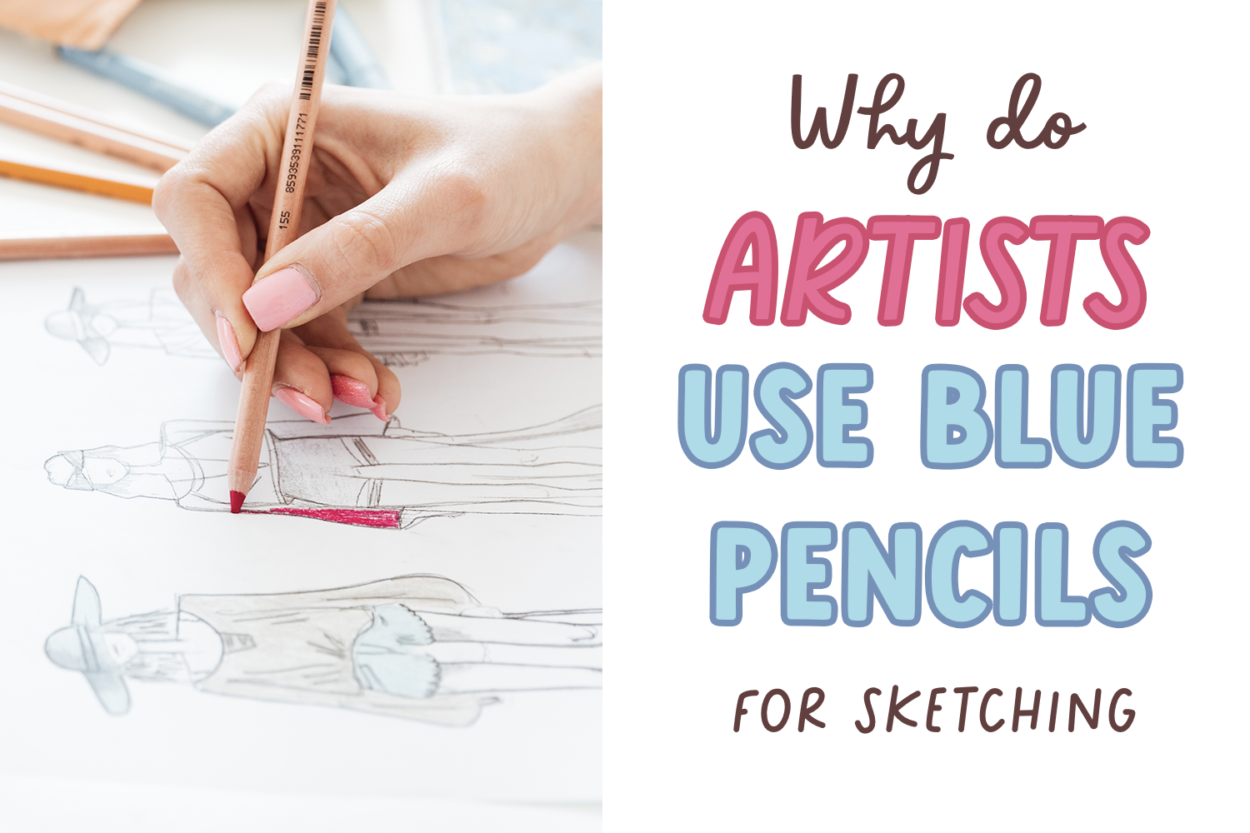You would have seen many pencil sketches and art tutorials online where artists and animators use blue and red pencils for sketching.
Maybe something like this:
Why do artists use blue pencils and are there any benefits to using a pencil for sketching?
- Blue pencils are very smooth and glide easily on paper making it the more obvious choice for rough sketches.
- Blue pencils make it easier to differentiate your rough sketches from your final drawing.
- Blue pencils are easily erasable as compared to graphite pencils.
- Blue pencils aren’t picked up easily by scanners or photocopiers, this means you don’t have to erase the rough sketch.
There are multiple benefits to using blue/red pencils for sketching. I will explain why artists use it as well as why animators use it.
I’ll then talk about how you can use a blue pencil correctly and what is the best one to use right now.
This post includes affiliate links. If you do decide to purchase something, I will make a commission at no extra cost to you. For more information, please read my entire Privacy Policy here.
Table of Contents
Why do Artists use blue pencils for sketching/drawing?
1. It makes it very easy for rough sketches and base drawings
Whenever you start a pencil sketch, especially if you’re drawing without reference, you need to have a rough sketch on paper first.
If you do that with a proper graphite pencil, you’re going to find it very hard to sketch over that, since there is no difference between the rough sketch and the main sketch color.
When the rough sketch is in blue, it’s easier on the eyes to sketch over it during your final sketch or inking process.
So, most artists actually prefer drawing poses, postures, anatomy, or breaking down complex objects into basic shapes by using a blue pencil.
Now, once the rough sketch is complete, the artist is able to get a clear perspective of what they want to draw, and they’re able to go over it with their inking tools, graphite pencils, or watercolor.
Some artists prefer for their base drawings to be prominent even after sketching over them with graphite pencils as it provides more depth to their drawings.
2. It glides on paper easily
Blue pencils are very smooth on sketching paper and artists find it very easy to roughly sketch on paper using blue pencils.
Blue pencils are more smooth than proper graphite pencils and artists generally prefer drawing their rough sketches with a blue pencil because these starter lines are not very harsh and can also be erased later on.
When you’re using a blue/red pencil for sketching, you’ll find that it’s easier to sketch. This is something you’ll only gain more experience in if you try it for yourself.
It’s also very easy to draw over these blue lines and the texture of the paper is not affected when you’re drawing over it via graphite or ink.
Just make sure you’re using a non-photo blue pencil like this so that it won’t get scanned or picked up by your scanner or photocopier.
Which brings me to my next point…
3. Blue Pencil marks are easily erasable
Now, if you do a rough sketch with a proper gray graphite pencil (the standard pencils for sketching), you’re going to find it very difficult to erase the rough lines on the paper.
This is because graphite is pretty difficult to erase especially since the color is dark gray.
The rough sketch is going to be visible on the final drawing and it will even make it very difficult to scan or photocopy since the gray marks left behind will be picked up by the photocopier.
Blue pencils on the other hand are very easy to erase and that’s why most artists and animators use blue pencils for drawing their
4. Blue pencils don’t smudge
When you’re doing your final drawing over the rough sketch, blending and smudging are crucial. This is why we use graphite pencils for drawing and pencil sketching.
However, your rough sketch needs to be very clean and it should not smudge. That’s why it’s better to use a blue/red pencil for rough sketches.
Blue pencils (also known as col-erase pencils) aren’t made of graphite.
They’re waxier and don’t smudge at all. You can draw beautiful lines of motion – this is why animators use them!

That’s why a lot of artists prefer drawing their rough sketches in red/blue pencil. Because most of these sketches are inside books/moleskines.
They won’t smudge or get ruined after closing the book and you don’t need to spray any protector on your sketches if you use a red/blue pencil.
You can take a look at multiple sketches online on Pinterest or Instagram.
And sketches that are in blue or red look much more professional and beautiful. Most Moleskine artists also prefer using red/blue pencils because it’s so much better to look at.
5. Blue pencil marks are hardly visible after the final sketch
When you’re doing your preliminary sketch using a blue pencil, the marks will be very dark and you’ll be able to see your rough sketch easily.
However, after you go over the sketch with graphite pencils or ink, the blue lines will hardly be visible.
This means your rough sketch won’t ruin your final drawing by being prominent on the paper.
It provides a neat aesthetic and is very clearly distinct from the final drawing lines.
Artists prefer using blue pencils for notes, rough sketches, and lines of motion so that the final image after scanning will be devoid of all these blue pencil annotations.
6. Blue pencils weren’t picked up by scanners/photocopy machines
Earlier, scanners used a chemical film that wasn’t sensitive enough to pick up a few shades of blue. This led to artists and designers using this blue pencil to draw their rough sketches with it because the blue wasn’t easily picked up by scanners.
But if you used a graphite pencil for the rough sketches and erased it, the scanner would still pick up the marks and your drawing would look messy.
This is why so many artists preferred using non-photo blue pencils to do their rough sketches.
However, now, scanners will still pick up the blue color ever so lightly, so you need to make sure you’re using the non-photo blue pencil when you’re doing your sketches (if you don’t want them to be seen).
Why do animators use blue pencils?
If you visit an Animation Industry, you’ll find that several animators and artists are working on a particular scene in the animation.
You’ll have one for clothes, one for backgrounds, one for objects and so on.
When you have so many animators, it’s preferable that each animator in the team uses a different color. This will make it easy for manipulations later and it will be easy to identify who has to make what change/edit.
It’s also way easier to see all the objects together when you’re using different colors like blue, green, red, and so on.
If everything is drawn using graphite pencils, it will become difficult to differentiate objects during the rough sketch phase.
What is the best blue pencil for sketching?
The Prismacolor Copy-Not Col-Erase non-photo blue pencil in shade #20028 is the best blue pencil for sketching.
It isn’t very waxy and will provide clean sketch lines.
Using this pencil will ensure that your rough sketches are very light and you’ll find it very easy to draw over these rough lines with your graphite pencils.
However, if you want darker blue strokes, then you can use the regular Prismacolor non-photo blue pencil.
How to use a blue pencil for sketching correctly?
When you’re using a blue pencil for creating your rough sketch, do not press hard.
Please note that the non-photo blue pencil (Copy-Not Col-Erase) in shade #20028 is a very light blue colored pencil.
If you press hard, you’re going to damage your paper and it will not be erasable. And when you’re doing your final sketch with your graphite pencil, you’ll find it difficult to pencil sketch since the graphite won’t slide easily on the paper.
Instead, go over the line multiple times over the same area, till the stroke appears darker.
Conclusion
I hope this post provided you with enough insight to understand how you can use a blue pencil correctly and why we use them as artists.
You can check out other posts below that you might find helpful:
- How to draw without using a reference
- 10 things I wish I knew before becoming an Illustrator
- How to start digital art
- 7 ways to get back into drawing after taking a long break
- How to respond to compliments as an artist
- Does drawing increase creativity? Explained
- How to draw when you don’t feel like drawing – 13 easy ways
- How to get better at drawing (for beginners)
- How to find your art style when you’re a beginner artist
- 13 signs you were meant to be an artist
- How long does it take to learn how to draw? (Explained)
- How to become a full-time artist without a degree
- How to sell art and make money on Instagram without a website
- 13 drawing mistakes most beginner artists make
- 9 drawing books for beginners
- Fun drawing gifts for children under 10 years old
- 13 easy ways to make money online as an artist
- 13 reasons why people like drawing + drawing benefits!
- 13 Ways to be a more Confident Artist







cool article thanks…
btw, did you know the name #Chibi is copyrighted and Trademarked…..
Hey Tia,
I’m glad you loved it. Oh, I didn’t know that! Makes sense. A lot of words are copyrighted. =)
Warm regards,
Angela